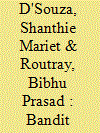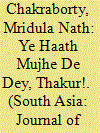|
|
|
Sort Order |
|
|
|
Items / Page
|
|
|
|
|
|
|
| Srl | Item |
| 1 |
ID:
142616


|
|
|
|
|
| Summary/Abstract |
Its long history and destabilising impact notwithstanding, banditry has received scant academic attention in India. Confined mostly to occasional and incident-driven media reportage, the socioeconomic factors that fuelled insurgencies and banditry and the milieu which provided a context for the operations of these outlawed movements received little attention. Cinematic representation of the social banditry phenomenon in the country, based on little or no first-hand research, as a result, suffered from ingenuousness and failed to emerge from the romanticised depiction of insurgency and terrorism which Bollywood, India's movie industry, is known for. Bandit Queen, the biopic of Phoolan Devi, in contrast, stands apart. Scathing criticisms regarding its use of sex as a tool for commercial success notwithstanding, the movie succeeds in drawing the viewers' attention to the persisting social cleavages in India. Using rape as its central theme, it shocks its audience into acknowledging the reality and relevance of social banditry in a country where governance remains an absent entity for a vast majority of its people. That most Bollywood movies depicting social issues have continued to remain aground in romanticism and irrelevance makes Bandit Queen even more relevant in times to come.
|
|
|
|
|
|
|
|
|
|
|
|
|
|
|
|
| 2 |
ID:
137263


|
|
|
|
|
| Summary/Abstract |
This essay argues that the figure of the dacoit/daku in Bombay cinema functions as the subaltern who is interpellated by, and yet cannot be contained by, the strictures of ‘modern’ law in a newly-independent post-colonial state. Reminiscent of an older polity, where rural outlaw figures operated as rebels to the existing social order inflected by caste and gender, dacoits in popular Hindi films give voice to the peasant insurgent, dispossessed of his land by age-old caste-based, as well as new, forms of governance. Taking up three screen dacoit characters in Bombay cinema, Gabbar Singh from Sholay (1975), Phoolan Devi from Bandit Queen (1994) and Paan Singh Tomar from Paan Singh Tomar (2010), this paper argues that in its obsession with the representation of dakus, Bombay cinema betrays its anxiety about a post-colonial juridical order that continues with the oppressions of feudal and colonial hierarchies. Thus, Bombay cinema continues to rely on the subaltern as idea and concept in order to map the tension between a nationalist/statist history and a narrative of rebellion and resistance from below, particularly in caste terms. (The term ‘Ye haath mujhe de dey, Thakur!’, from Sholay, translates as ‘Give me these hands, Thakur!’).
|
|
|
|
|
|
|
|
|
|
|
|
|
|
|
|
|
|
|
|
|